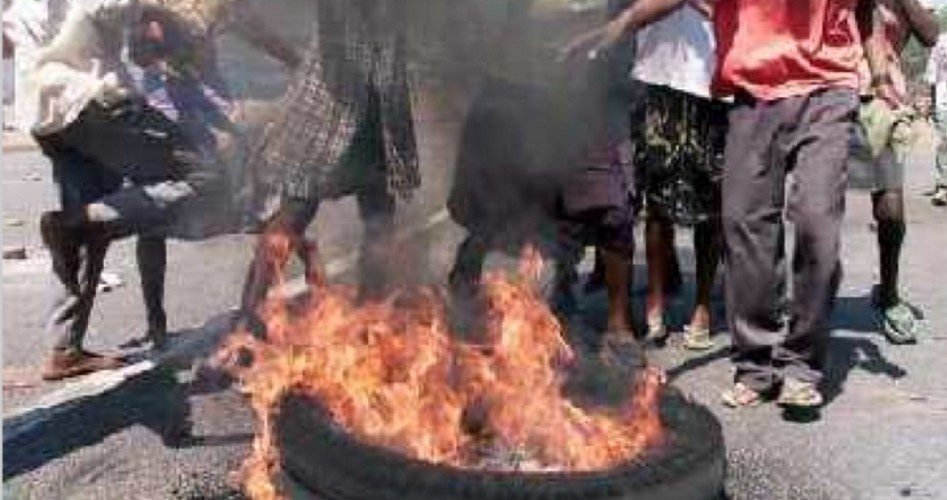
The scene is a gloomy shanty somewhere in Soweto, the sprawling black township on the outskirts of Johannesburg. Standing around the room are a group of young black radicals known as “comrades,” and hanging ominously on the walls are some old tires. The air is hot and heavy, the atmosphere solemn. The “People’s Court” is in session.
Someone issues an order, and the accused party is roughly hauled in. Like his accusers and judges, the accused is black. Unlike the others in the room, however, he is not a dedicated participant in the Marxist revolution sweeping through the black townships in South Africa. For that reason he is now on “trial.”
The “defendant” is charged with the crime of collaborating with “the system” and with the police. The comrades, acting as prosecutor, judge, and jury, do not worry about such legal niceties as proof and the rights of the accused. The trial is short and to the point. The verdict is foreordained: guilty. As is the sentence: death by “necklace.”
The sentence is carried out swiftly. As the victim sobs and pleads for mercy, his hands are tied behind his back with barbed wire. A rubber tire is placed around his neck, and another is placed around his legs. The comrades force the condemned man to drink some petrol, and the rest is poured over the victim and the tires. Then, one of the comrades lights a match.
Engulfed in flames, the victim falls to the ground and writhes in agonizing pain. The rubber tires ensure a very hot fire, and the melting rubber eats into his flesh. Amidst his cries, the comrades gather around and taunt him with a callousness that defies human understanding. Finally, after 20 minutes of intense suffering and pain, death mercifully ends the victim’s horrible agony.
“Yes, it surely is a horrible way to die,” a 16-year-old comrade in Soweto named “Killer” publicly confessed. “But the people we necklace have committed horrible crimes and deserve to die horribly.”
As an integral part of the African National Congress’s (ANC’s) Marxist campaign to spread fear and terror throughout the black townships, necklacing has become one of the comrades’ chief tools in showing the decent, law-abiding residents of those communities who is in control. Because of the importance of this tactic in the overall Communist attack on South Africa, murder by necklace has been committed at the rate of one per day over the past year.
Since the purpose of necklacing is to spread fear, such executions are committed publicly whenever possible. The comrades are in fact quite proud of their favorite torture technique, which in many respects resembles the cruelty of the Roman Empire’s crucifixions, and publicly boast of their evil deeds. A 21-year-old comrade named Bongani, for instance, has described how he helped murder a 20-year-old black youth who had brought a tape recorder to a rally.
“He was screaming for mercy and crying that he would never do it again and that he didn’t know what he was doing and that he was sorry. We set him on fire.” Bongani, who is Killer’s friend, added, “If other would-be informers see today what could happen to them tomorrow, then they won’t take the job.”
But alleged “informers” have not been the only victims of the comrades’ brand of “justice.” Township officials and black policemen have also been favorite targets. Other victims have included migrant miners, who were condemned because mines were deemed essential parts of “the system,” as well as liquor store owners, who were condemned for operating under government licenses. Blacks who have dared to disregard a boycott or a strike called by the Marxist revolutionaries have also found themselves facing the “People’s Court.” A 20-year-old black youth was once necklaced because he held a party in defiance of a “people’s ban” on Christmas celebrations.
Comrade Killer has publicly described with cold indifference how he helped to murder a 62-year-old black woman named Mary Skhosana. Since the funeral parlor that employed her sold funeral insurance, the “People’s Court” found her guilty of collaborating with “the system.”
“We knew she was a police informer. We did not need proof,” Killer stated. “She was pleading for mercy and crying and screaming. She said she’d pay us 7,000 rands [$3,080] if we let her go. We told her we didn’t need her money; we needed her life. Then we put a tire around her legs and another around her neck and shoulders. We forced her to drink petrol. We poured the rest into the tires and onto her and set her alight. But the fire went out. Another tin of petrol was fetched, and it took about an hour.”
Inspired by that bleak reality, a grim joke has been circulating in South Africa in reference to necklacing and the United Democratic Front (UDF), an umbrella organization of anti-apartheid groups and front for the comrades’ ANC. Question: “What does UDF stand for?” Answer: “Uniroyal, Dunlop, and Firestone.”
But this newest Communist method of torture and murder is dearly no joking matter. Although the international news media have been negligent in reporting on this technique of black-on-black violence, nearly all candid observers agree that necklacing has been brutally effective in its goal of terrorizing the decent, civilized segments of South Africa’s black population.
Diliza Machoba of the South African Council of Churches sums it up this way: “When you attend a funeral and you hear these young comrades chanting, ‘Long live the necklace,’ you’re going to think twice about doing anything which will in any way offend the comrades. It is the ultimate deterrence.”



